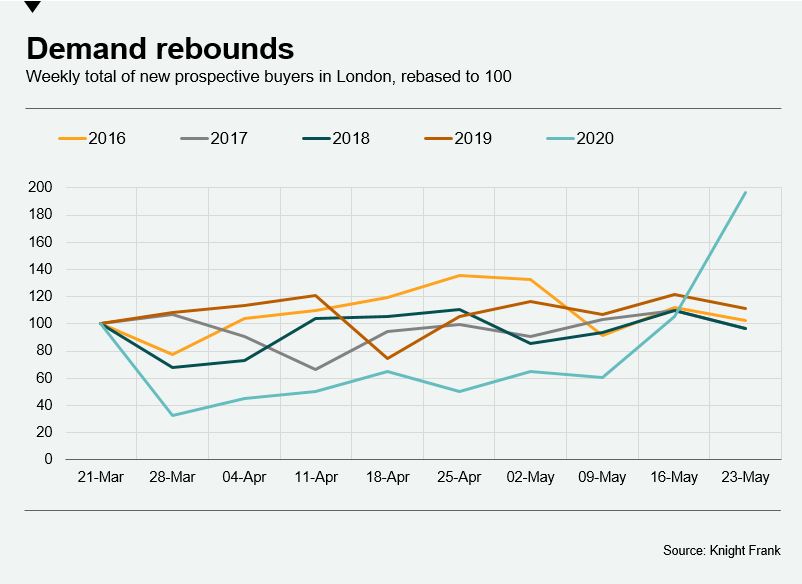Demand surges in first full week of trading
Balance between the number of sellers and buyers in coming weeks will determine what happens to prices
3 minutes to read
Demand for UK property surged in the first full week of trading since the market reopened, in a further sign that price declines are bottoming out.
The number of new prospective buyers registering in London was 28% higher than the five-year average in the week ending 23 May, as seasonal patterns of demand continue to be skewed by the Covid-19 pandemic (see chart).
Knight Frank estimates that more than 500,000 UK property sales will be lost in 2020 as social distancing restrictions and the economic impact from the pandemic take their toll on the property market. However, rules have been relaxed for the market ahead of other sectors and the full extent of pent-up demand will become clear in coming weeks.
“It feels like we’ve picked up where we left off, namely the busiest spring market in six years,” said Christopher Burton, head of Knight Frank’s Dulwich office. “We launched a house on Monday at £1.9 million and after receiving five offers, the owner accepted a bid above the asking price.”

Demand in the lettings market rebounded in a similar way last week. The number of new prospective tenants in London and the Home Counties was 9% higher than the five-year average, which compared to a 59% decline in the first week of lockdown.
While the number of new prospective buyers typically builds through the first half of the year, last week’s total was 9% lower than the second week of March, underlying how the market has not fully returned to normal.
However, the figure recorded in March was itself 41% higher than the five-year average, demonstrating the strength of demand that had built in the period following December’s general election.
The immediate impact of the re-opening was less marked outside the capital. While the number of new prospective buyers was also the highest total since the second week of March, it was 18% below the five-year average. That compares to 84% below in the first week of lockdown.
Declines in new supply have also narrowed. The number of new sellers last week was 68% below the five-year average, which compares to a decline of 91% in the last week of April. Supply has not rebounded as quickly as demand because valuing and listing a property requires more time.
How the balance between buyers and sellers evolves in coming weeks will determine the trajectory for prices this year. For now, buyers are more active.
“Buyers are currently expecting discounts, but don’t realise the volume of enquiries we have had,” said Adam Burlison, head of Knight Frank’s Esher office. “The perception doesn’t match the reality.”
Damian Gray, head of Knight Frank’s Oxford office agrees. “Buyers are learning that they have to be in a position to buy if they are to compete with other buyers,” he said.
However, sellers need to acknowledge the uncertainty created by the pandemic, says Laura Dam Villena, head of Knight Frank’s Queen’s Park office. “My sense is that vendors still want to achieve 2016 prices but buyers are acutely aware of the wider picture. The volume of sales will be highly dependent on how realistic vendors are with their prices.”